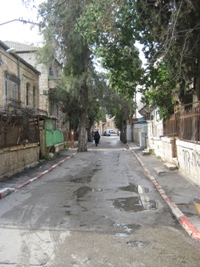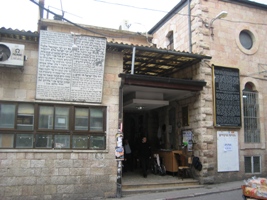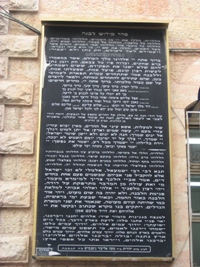‘Parashat Bo’ is one of my favorite weekly portions of the Tora. The book of Genesis holds many of the most interesting stories. These stories set example for human behavior for centuries.
However, I still feel there is something missing in the book of Genesis. There is no Halakha in the book of Genesis, no rules as for the way the Jewish people should conduct its day to day life. Actually, the first ‘Mitzva’ (or commandment) in the bible that concerns not only individual ancestors but the whole Jewish people is given in the parashat Bo. As a person who takes interest in the history of the Jewish people I think this is a significant issue. A commandment given to one person is an individual case with a lesson to be learned. A commandment given to a nation gives us a basis for the study of the way Jewish communities all over the world chose to live their lives for centuries. It should not surprise us that Rashi thinks in a similar way. Even when he writes his first interpretation at the beginning of the book of Genesis he says: “The bible should have been opened with the words “…This month is to be the beginning of months for you” (Exodus 12:2) which is the first mitzvah given to the Israelis. This verse is taken of course from the Parasha of Bo.
The parasha of Bo includes a few important events: The last three of the plagues of Egypt, Some sensitive meetings between Pharaoh, Moses and Aaron (one of the meetings includes the saying “we will go with our young and our old” Exodus 10:9, a phrase later used by Shmuel Yosef Agnon in a wonderful short story that carry the same name), The first Passover occasion, The banning of Leavened food (Chametz), The explanation for Tefillin (phylacteries) and much more. I, as you probably guessed, chose to look at the verse “This month is to be the beginning of months for you; it is the first month of your year” (Exodus 12:2). This first Mitzva is not negligible. As a matter of fact this commandment establishes a base for every Mitzva which is time dependent. It lies as a foundation to the Jewish calendar – a lunar calendar starting at the month of Nisan. The clearest interpretation for the mitzvah is given naturally by Rashi who uses the Midrash of Shmot Raba: “and thus he showed him (God to Moses) the moon in its renewal and told him that when the first of every month will be when the moon is reborn… And he told him that the month of Nisan will be the first of the months”.
I went to the streets of Jerusalem to look for a physical realization of the concept of Rosh chodesh (The first day of the Jewish month) and the renewal of the moon. Walking for a while I got to Zichron Moshe neighborhood, one of the five neighborhoods named after Moshe Montefiore. In the past, the neighborhood was a symbol of progress and, at the days of World war one, was considered the most modern neighborhood in Jerusalem. The first Hebrew kindergarten was founded there (The kindergarten teacher was Hassia Feinsood-Sukenick, Yigal Yaddin’s mother. In the neighborhood of Gillo there is a main street called after her – Haganenet Street). In this neighborhood the Hebrew Gymnasia of Jerusalem was built and many well educated figures like David Yellin lived there. Today things are different. Instead of a modern neighborhood you can find there many old houses and the residents represent the old Jewish settlement rather than the new one. The neighborhood is now completely ultra orthodox. In the same class that was used as the first Hebrew kindergarten young children speak Yiddish, The near by Edison cinema that controversially screened movies even on Saturdays was destroyed in order to build a public gathering place for the ultra orthodox community. In the neighborhood there is an impressive number of Synagogues. On many walls, near the entrance to the Synagogues you can find table for Kiddush Levana (the prayer of the sanctification of the moon).
The Mitzva of Kiddush Levana involves a commandment to watch the “young” moon outside the synagogues door under the starry sky. You can say the prayer any time between the third day of the month to the fifteenth, however, most people will prefer to follow the “Shulchan Aruch” (The Jewish code of law) and say it at the end of the Shabbat day following the third day of the month. That day people exit the synagogue and pray in a place which is usually dark. Many synagogues hang a large sign with the Blessing of the moon in big visible letters just near the entrance. In Hebrew we have a phrase which literally means “Letters of the moon blessing” ( Otiyot Kiddush Levana) and it is used to describe large clear writing.
In the synagogue of Zichron Moshe (8 Chafetz Chaim Street, Zichron Moshe neighborhood) they took the idea of Kiddush Levana Boards and went one step further and decided to put the blessing on two boards instead of one. When you know that synagogue is a Shtiebel, a place that hosts many Minyanim (Jewish prayer quorums) all day and night long. A man who woke up late and still want to participate in a public prayer can find a late morning Minyan. The same goes for a man who wants to pray the evening prayer at two a.m. For this reason and because many respected preachers attend the place, the synagogue became one of the busiest in Jerusalem and once a month on the designated Shabbat evening you can join the huge crowed praying Kiddush Levana, The same moon that is the root of the first commandment in the Bible, the Mitzva in the Parasha Of Bo.


